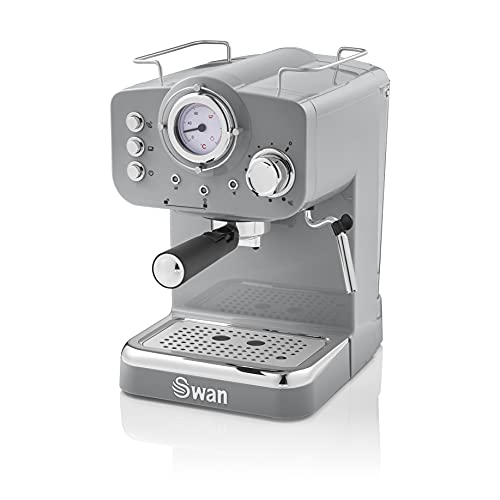What to Look For in a Commercial Espresso Machine
When you purchase a commercial espresso machine, there are several aspects to take into consideration. The volume of your cafe, the intended service use and barista knowledge will determine which type of espresso machine is the best for your business.

Double boiler systems offer the ability to brew and steam simultaneously. It also reduces recovery time between pulls. Proportional-integral-derivative (PID) temperature control manages on/off cycles for optimal boiler temperatures.
Productivity
A commercial espresso machine is designed to handle a much greater volume of coffee brewing than an espresso machine at home. The idea of allowing a home espresso machine to function in a professional environment would be an invitation to disaster.
A commercial machine of the highest quality will be able to serve up to 100 cups per hour during peak hours. This can be a lifesaver in busy workplaces, since it stops employees from waiting around to get their coffee.
A coffee maker can help workers bond. Teams of people usually have coffee in a rotating manner for one another, which could promote collaboration and teamwork in the workplace. A dedicated space to enjoy coffee can assist new employees to feel at peace in the workplace, and break down any barriers between them and senior staff members.
Commercial espresso machines come in various sizes to cater for different needs. Some models are fully automated and some can be programmed with pre-programmed espresso shot sizes so that operators do not have to guess the correct size. This is particularly crucial for businesses with inexperienced baristas, as incorrect shots can significantly affect the strength and flavor of espresso brewed. Additionally, it's recommended to purchase ethically sourced and manufactured commercial espresso machines that help the communities where coffee is produced. This will guarantee a high quality product and minimize the negative impact on the environment.
Safety
Espresso machines are massive machines that weigh a lot that can cost more than a brand new compact car. They're also built to pump out hundreds of shots and drinks throughout the course of one day. Commercial espresso machines can pose unique health and safety risks for staff due to their high volume.
Keep in mind that commercial espresso machines will likely to make use of warm water. This can lead to the growth of bacteria. Machines that are poorly maintained and not regularly cleaned and descaled may accumulate spent espresso. This can cause it to turn rancid and may cause illness if consumed by customers. A commercial espresso machine with a steam wands that are not sealed could allow bacteria to grow in the milk the frothing process.
Take into consideration the type of beverage you will serve and how many cups per hour your space can accommodate when choosing the right commercial coffee machine. It is important to select an espresso machine with automation capabilities which will allow you to serve your customers the best coffee drink. Also, look for a guarantee that covers parts and labor to ensure that any technical issues are addressed quickly and effectively.
Energy Efficiency
Commercial espresso machines require substantially more power than home models. Professional espresso machines weigh more and come with larger boilers in order to support several group heads for standard cafe production. These machines also operate at a much higher temperature in the ambient and are typically in an indoor space (such as a coffee shop or restaurant) where the electronic components can overheat rapidly, leading to malfunctioning machines.
The boiler of commercial espresso machines heats and holds pressurized drinking water supplied by an electric pump. This water is used to brew and steam espresso. The boiler is made up of a number of copper tubes that are heated by electric elements. When the brew level sensor detects that the water has reached its goal level, a solenoid valve opens to let the boiler fill with water that is fresh and the heating element turns off.
There are four different types of espresso machines. They are differentiated in their capacity to steam or brew in the form of The TB (brewing-only), TX (twin-boilers), HX (double automated) and DA (double automated). www.coffeee.uk and TX machines ensure stable brew temperatures while DA allows rapid steaming from a single boiler. Many cafes are switching to HX machines since they have been shown to offer the best of both worlds, in terms of the temperature of steam and brew.
Maintenance
Like cars require routine tune-ups commercial espresso machines need maintenance to run smoothly and efficiently. If you take the time to keep your machine in good condition, it will provide you better tasting coffee and last longer.
It's a daily ritual to clean your espresso machine, but you should be aware of the parts that require an extra clean. There's bound to be leftovers from the coffee grounds and milk products inside the machine that could cause the breakdown of various components over time. Regular cleaning helps to prevent this and keeps your espresso machine functioning at to its maximum.
The majority of espresso machines in commercial use require descaling every three months. This is a process that requires additional steps than regular cleaning, so it's best to read the manual to ensure that you're following the instructions. The solution used for descaling the tank dissolves the scale. You'll need a container to complete this task. In certain models there may be a container underneath the coffee spouts. Then, follow the instructions for your specific model.
A water filter change is an additional maintenance step. This can be overlooked but is essential to remember so that you don't get a build-up of mineral deposits. Look for calcification, which can be difficult to remove in the spray head.
